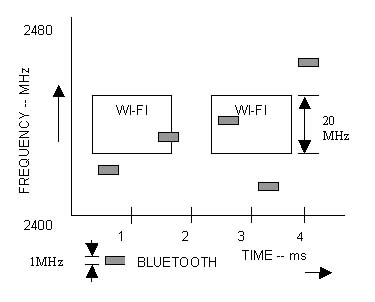Bluetooth And 802.11 WLAN Coexistence

By Alan Bensky
Ateret Radio Engineering
Abstract
With the recent rise of Bluetooth product sales and the already large and growing use of wireless local area networks (WLANs), there is considerable concern about mutual interference between Bluetooth enabled and WLAN devices. Both occupy the 2.4 to 2.4835 GHz unlicensed band and use wideband spread spectrum modulating techniques. They will most likely be operating concurrently in the same environments, particularly office/commercial but also in the home. The IEEE 802.15 Task Group 2 made an extensive study of WPAN (wireless personal area network -- Bluetooth is example)/WLAN coexistence and a summary document, Standard IEEE 802.15.2, was published in 2003. This article reviews the interference mechanism that affects the two systems, develops a criterion of radius of interference, discusses ways to improve coexistence, and presents recent changes in the FCC regulation that accommodate partial solutions to the compatibility problem.
Introduction
In this paper, WLAN 802.11 is referred to by its common name -- Wi-Fi. This name covers any variant of the IEEE 802.11 specification whose identifying characteristics are listed in Table 1. More specifically, our interest is in IEEE 802.11b using the DSSS (direct sequence spread spectrum) or high rate (5.5 or 11 Mbps) mode, since it is by far the most prevalent. 802.11a is excluded because it operates on 5 GHz bands not affected by Bluetooth transmissions. The highest rate version of 2.4 GHz Wi-Fi, 802.11g, uses a significantly different modulation technology than 802.11b, but the principles of interference are essentially the same.

*United States. Frequencies are different in some other countries.
While Bluetooth has only one raw data rate -- 1 Mbps -- the variants of 802.11 have several. The criterion for the amount of interference caused is the throughput degradation -- the ratio of the throughput that would be achieved if there were no interference to the actual throughput with interference.

Figure 1
Interference can occur when a terminal of one network transmits on or near the receiving frequency of a terminal in another collocated network with enough power to cause an error in the data of the desired received signal. Although they operate on the same frequency band, the nature of Bluetooth and Wi-Fi signals are very different. Bluetooth has a narrow band transmission of 1 MHz bandwidth which hops around pseudorandomly over an 80 MHz band, while Wi-Fi (using DSSS) has a broad -- approximately 20 MHz -- bandwidth that is constant in some region of the band. The interference phenomenon can be visualized with the aid of Figure 1. Whenever there is a frequency and time coincidence of the transmission of one system and reception of the other, it's possible for an error to occur. Whether it does or not depends on the relative signal strengths of the desired and undesired signals. These in turn depend on the radiated power outputs of the transmitters and the distance between them and the receiver. When two terminals are very close (on the order of centimeters) interference may occur even when the transmitting frequency is outside the bandwidth of the affected receiver.
Click here to download the complete article in pdf format.
About the author
Alan Bensky, MScEE, is an electronics engineering consultant with over 25 years of experience in analog and digital design, management, and marketing. Specializing in wireless circuits and systems, Bensky has carried out projects for military and consumer applications. He is the author of Short-range Wireless Communications, Second Edition, published by Elsevier in 2004, and has written several articles in international and local publications. He has taught courses and gives lectures on radio engineering topics. Bensky is a senior member of IEEE. He can be contacted at abensky@ieee.org.
